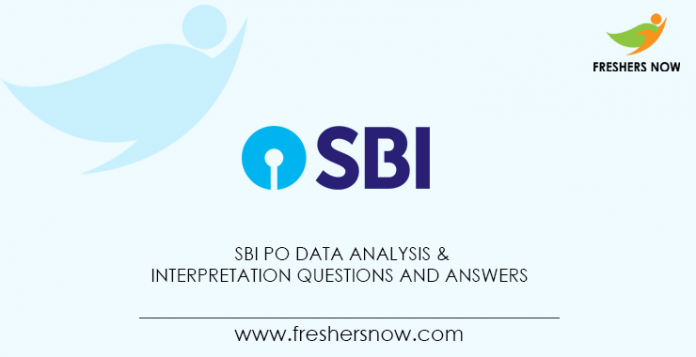
SBI PO Data Analysis & Interpretation Questions and Answers PDF Download (Mains): Check this entire article, and get the details on SBI PO Data Analysis & Interpretation Questions With Answers. Candidates who have started preparing for the exam must and should have a focus on this article for the SBI PO Mains Data Analysis & Interpretation Questions and Answers.
★★ SBI PO Prelims Mock Tests ★★
SBI PO Data Analysis & Interpretation Questions and Answers
In the below sections, we have given detailed information on SBI PO Data Analysis & Interpretation Questions and Answers With Solutions. For the sake of applicants, we have attached the direct links to download the SBI PO Data Analysis & Interpretation Online Exam Questions and Answers at the end of this page.
SBI PO Data Analysis & Interpretation Mains Questions and Answers
Candidates who are very much interested to garb this opportunity need to check this article for the SBI PO Data Analysis & Interpretation Mains Questions and Answers details. These SBI PO Data Analysis & Interpretation Questions and Answers help applicants to know the structure of the exam paper. So, we advise all the candidates to prepare well for the exam by collecting the given SBI PO Data Analysis & Interpretation Questions and Answers.
SBI PO Data Analysis & Interpretation Questions with Answers
Expenditures of a Company (in Lakh Rupees) per Annum Over the given Years.
| Year | Item of Expenditure | ||||
| Salary | Fuel and Transport | Bonus | Interest on Loans | Taxes | |
| 1998 | 288 | 98 | 3.00 | 23.4 | 83 |
| 1999 | 342 | 112 | 2.52 | 32.5 | 108 |
| 2000 | 324 | 101 | 3.84 | 41.6 | 74 |
| 2001 | 336 | 133 | 3.68 | 36.4 | 88 |
| 2002 | 420 | 142 | 3.96 | 49.4 | 98 |
- What is the average amount of interest per year which the company had to pay during this period?
A. Rs. 32.43 lakhs
B. Rs. 34.18 lakhs
C. Rs. 33.72 lakhs
D. Rs. 36.66 lakhs
Answer – D. Rs. 36.66 lakhs
Explanation:
The average amount of interest paid by the Company during the given period
= Rs. (23.4 + 32.5 + 41.6 + 36.4 + 49.4 / 5) lakhs
= Rs. (183.3 / 5) lakhs
= Rs. 36.66 lakhs.
2. The total amount of bonus paid by the company during the given period is approximately what percent of the total amount of salary paid during this period?
A. 1%
B. 1.25%
C. 0.1%
D. 0.5%
Answer – A. 1%
Explanation:
Required percentage = ((3.00 + 2.52 + 3.84 + 3.68 + 3.96) / (288 + 342 + 324 + 336 + 420) * 100)%
= (17 / 1710 * 100)%
= 1%.
3. The total expenditure of the company over these items during the year 2000 is?
A. Rs. 501.11 lakhs
B. Rs. 478.87 lakhs
C. Rs. 544.44 lakhs
D. Rs. 446.46 lakhs
Answer – C. Rs. 544.44 lakhs
Explanation:
Total expenditure of the Company during 2000
= Rs. (324 + 101 + 3.84 + 41.6 + 74) lakhs
= Rs. 544.44 lakhs.
4. Total expenditure on all these items in 1998 was approximately what percent of the total expenditure in 2002?
A. 62%
B. 66%
C. 69%
D. 71%
Answer – C. 69%
Explanation:
Required percentage = (((288 + 98 + 3.00 + 23.4 + 83) / (420 + 142 + 3.96 + 49.4 + 98)) * 100)%
= (495.4 / 713.36 * 100)%
= 69.45%.
5. The ratio between the total expenditure on Taxes for all the years and the total expenditure on Fuel and Transport for all the years respectively is approximate?
A. 4:7
B. 15:18
C. 5:8
D. 10:13
Answer – D. 10:13
Explanation:
Required ratio = ((83 + 108 + 74 + 88 + 98) / (98 + 112 + 101 + 133 + 142))
= (451 / 586)
= 1 / 1.3
= 10 / 13
6. What is the ratio of the total sales of branch B2 for both years to the total sales of branch B4 for both years?
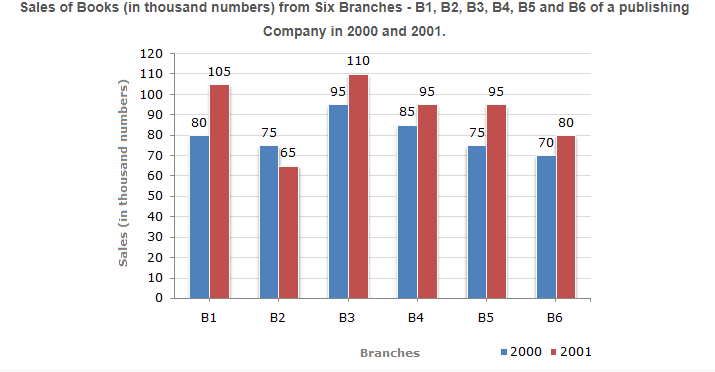
A. 2:3
B. 7:9
C. 3:5
D. 4:5
Answer – B. 7:9
Explanation:
Required ratio = (75 + 65) / (85 + 95)
= 140 / 180
= 7 / 9
7. Total sales of branch B6 for both the years is what percent of the total sales of branches B3 for both the years?
A. 68.54%
B. 71.11%
C. 73.17%
D. 75.55%
Answer – C. 73.17%
Explanation:
Required ratio = ((70 + 80) / (95 + 110) * 100)%
= (150 / 205) * 100)%
= 73.17%
8. What percent of the average sales of branches B1, B2, and B3 in 2001 are the average sales of branches B1, B3, and B6 in 2000?
A. 75%
B. 77.5%
C. 82.5%
D. 87.5%
Answer – D. 87.5%
Explanation:
Average sales (in thousand number) of branches B1, B3 and B6 in 2000
= 1 / 3 * (80 + 95 + 70)
= (245 / 3)
Average sales (in thousand number) of branches B1, B2 and B3 in 2001
= 1 / 3 * (105 + 65 + 110)
= (280 / 3)
Required percentage = (245 / 3 / 280 / 3 * 100)%
= (245 / 280 * 100)%
= 87.5%
9. What is the average sales of all the branches (in thousand numbers) for the year 2000?
A. 80
B. 83
C. 73
D. 88
Answer – A. 80
Explanation:
Average sales of all the six branches (in thousand numbers) for the year 2000
= 1 / 6 * (80 + 75 + 95 + 85 + 75 + 70)
= 80.
10. Total sales of branches B1, B3 and B5 together for both the years (in thousand numbers) is?
A. 250
B. 310
C. 435
D. 560
Answer – D. 560
Explanation:
Total sales of branches B1, B3 and B5 for both the years (in thousand numbers)
= (80 + 105) + (95 + 110) + (75 + 95)
= 560.
11. If for a certain quantity of books, the publisher has to pay Rs. 30,600 as printing cost, then what will be the amount of royalty to be paid for these books?
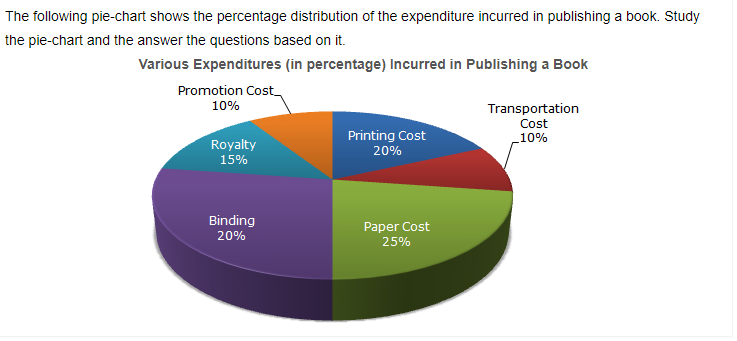
A. Rs. 19,450
B. Rs. 26,150
C. Rs. 22,950
D. Rs. 21,200
Answer – C. Rs. 22,950
Explanation:
Let the amount of Royalty to be paid for these books be Rs. r.
Then, 20 : 15 = 30600 : r => r = Rs. (30600 * 15 / 20)
= Rs. 22,950.
12. What is the central angle of the sector corresponding to the expenditure incurred on Royalty?
A. 15°
B. 24°
C. 54°
D. 48°
Answer – C. 54°
Explanation:
Central angle corresponding to Royalty = (15% of 360)°
= (15 / 100 * 360)
= 54°
13. The price of the book is marked 20% above the C.P. If the marked price of the book is Rs. 180, then what is the cost of the paper used in a single copy of the book?
A. Rs. 37.50
B. Rs. 42
C. Rs. 44.25
D. Rs. 36
Answer – A. Rs. 37.50
Explanation:
Clearly, the market price of the book = 120% of C.P.
Also, cost of paper = 25% of C.P
Let the cost of paper for a single book be Rs. n.
Then, 120 : 25 = 180 : n => n = Rs. (25 * 180 / 120)
= Rs. 37.50
14. If 5500 copies are published and the transportation cost on them amounts to Rs. 82500, then what should be the selling price of the book so that the publisher can earn a profit of 25%?
A. Rs. 187.50
B. Rs. 180
C. Rs. 191.50
D. Rs. 175
Answer – A. Rs. 187.50
Explanation:
For the publisher to earn a profit of 25%, S.P. = 125% of C.P.
Also Transportation Cost = 10% of C.P.
Let the S.P. of 5500 books be Rs. x.
Then, 10 : 125 = 82500 : x => x = Rs. (125 * 82500 / 10)
= Rs. 1031250
S.P. of one book = Rs. (1031250 / 5500)
= Rs. 187.50
15. Royalty on the book is less than the printing cost by:
A. 5%
B. 25%
C. 20%
D. 33 1 / 5%
Answer – B. 25%
Explanation:
Printing Cost of book = 20% of C.P.
Royalty on book = 15% of C.P.
Difference = (20% of C.P.) – (15% of C.P) = 5% of C.P.
Therefore Percentage difference = (Difference / Printing Cost * 100)%
= (5% of C.P. / Printing Cost * 100)%
= 25%
16. If the difference between the two expenditures are represented by 18° in the pie-chart, then these expenditures possibly are
A. Binding Cost and Promotion Cost
B. Paper Cost and Royalty
C. Binding Cost and Printing Cost
D. Paper Cost and Printing Cost
Answer – D. Paper Cost and Printing Cost
Explanation:
Central angle of 18° = (18 / 360 * 100)% of of the total expenditure
= 5% of the total expenditure.
From the given chart it is clear that:
Out of the given combinations, only in combination (d) the difference is 5% i.e.
Paper Cost – Printing Cost = (25% – 20%) of the total expenditure
= 5% of the total expenditure.
17. For an edition of 12,500 copies, the amount of Royalty paid by the publisher is Rs. 2,81,250. What should be the selling price of the book if the publisher desires a profit of 5%?
A. Rs. 152.50
B. Rs. 157.50
C. Rs. 162.50
D. Rs. 167.50
Answer – B. Rs. 157.50
Explanation:
Clearly, S.P. of the book = 105% of C.P.
Let the selling price of this edition (of 12500 books) be Rs. x.
Then, 15 : 105 = 281250 : x => x = Rs. (28 * 281250 / 15)
= Rs. 1968750
S.P. of one book = Rs. (1968750 / 12500)
= Rs. 157.50
18. For which of the following pairs of years the total exports from the three Companies together are equal?
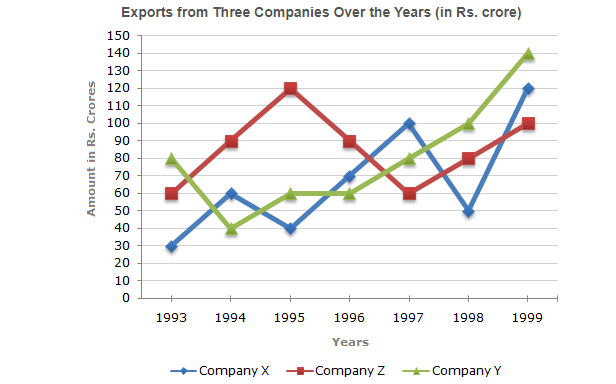
A. 1996 and 1998
B. 1997 and 1998
C. 1995 and 1998
D. 1995 and 1996
Answer – D. 1995 and 1996
Explanation:
Total exports of the three Companies X, Y and Z together, during various years are:
In 1993 = Rs. (30 + 80 + 60) crores = Rs. 170 crores.
In 1994 = Rs. (60 + 40 + 90) crores = Rs. 190 crores.
In 1995 = Rs. (40 + 60 + 120) crores = Rs. 220 crores.
In 1996 = Rs. (70 + 60 + 90) crores = Rs. 220 crores.
In 1997 = Rs. (100 + 80 + 60) crores = Rs. 240 crores.
In 1998 = Rs. (50 + 100 + 80) crores = Rs. 230 crores.
In 1999 = Rs. (120 + 140 + 100) crores = Rs. 360 crores.
Clearly, the total exports of the three Companies X, Y and Z together are the same during the years 1995 and 1996.
19. Average annual exports during the given period for Company Y is approximately what percent of the average annual exports for Company Z?
A. 87.12%
B. 89.64%
C. 91.21%
D. 93.33%
Answer – D. 93.33%
Explanation:
Analysis of the graph: From the graph, it is clear that
The number of exports of Company X (in crore Rs.) in the years 1993, 1994, 1995, 1996, 1997, 1998 and 1999 are 30, 60, 40, 70, 100, 50 and 120 respectively.
The number of exports of Company Y (in crore Rs.) in the years 1993, 1994, 1995, 1996, 1997, 1998 and 1999 are 80, 40, 60, 60, 80, 100 and 140 respectively.
The number of exports of Company Z (in crore Rs.) in the years 1993, 1994, 1995, 1996, 1997, 1998 and 1999 are 60, 90, 120, 90, 60, 80 and 100 respectively.
Average annual exports (in Rs. crore) of Company Y during the given period
= 1 / 7 * (80 + 40 + 60 + 60 + 80 + 100 + 140)
= 560 / 7
= 80.
Average annual exports (in Rs. crore) of Company Z during the given period
= 1 / 7 * (60 + 90 + 120 + 90 + 60 + 80 + 100)
= 600 / 7
Required percentage = (80 / 600 / 7 * 100)
= 93.33%
20. In which year was the difference between the exports from Companies X and Y the minimum?
A. 1994
B. 1996
C. 1997
D. 1995
Answer – B. 1996
Explanation:
The difference between the exports from the Companies X and Y during the various years are:
In 1993 = Rs. (80 – 30) crores = Rs. 50 crores.
In 1994 = Rs. (60 – 40) crores = Rs. 20 crores.
In 1995 = Rs. (60 – 40) crores = Rs. 20 crores.
In 1996 = Rs. (70 – 60) crores = Rs. 10 crores.
In 1997 = Rs. (100 – 80) crores = Rs. 20 crores.
In 1998 = Rs. (100 – 50) crores = Rs. 50 crores.
In 1999 = Rs. (140 – 120) crores = Rs. 20 crores.
Clearly, the difference is minimum in the year 1996.
21. What was the difference between the average exports of the three Companies in 1993 and the average exports in 1998?
A. Rs. 15.33 crores
B. Rs. 18.67 crores
C. Rs. 20 crores
D. Rs. 22.17 crores
Answer – C. Rs. 20 crores
Explanation:
Average exports of the three Companies X, Y, and Z in 1993
= Rs. (1 / 3 * (30 + 80 + 60)) crores
= Rs. 170 / 3 crores
Average exports of the three Companies X, Y and Z in 1998
= Rs. (1 / 3 * (50 + 100 + 80)) crores
= Rs. 230 / 3 crores
Difference = Rs. (170 / 3 – 230 / 3)
= 20 Crores
22. In how many of the given years, were the exports from Company Z more than the average annual exports over the given years?
A. 4
B. 2
C. 5
D. 3
Answer – A. 4
Explanation:
Average annual exports of Company Z during the given period
= 1 / 7 * (60 + 90 + 120 + 90 + 60 + 80 + 100)
= Rs. (600 / 7) Crores
= Rs. 85.71 crores.
From the analysis of the graph, the exports of Company Z are more than the average annual exports of Company Z (i.e., Rs. 85.71 crores) during the years 1994, 1995, 1996, and 1999, i.e., during 4 of the given years.
23. What is the ratio between the total number of students studying MCA from all three institutes together and the total number of students studying M.Sc. from all three institutes together?
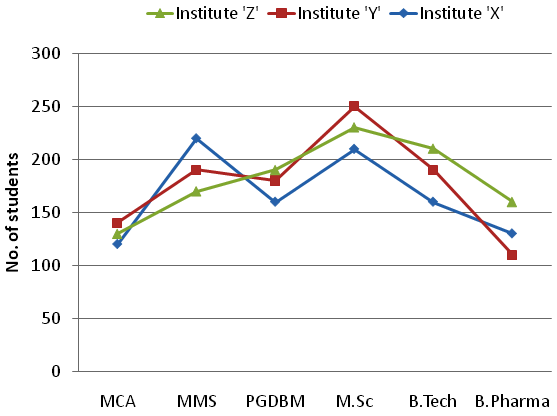
A. 13 22
B. 13:23
C. 14:23
D. 13:24
Answer – B. 13:23
Explanation:
Required ratio = 120 + 130 + 140 / 210 + 230 + 250
= 13 / 23
= 13:23
24. Number of students studying MMS from institute ‘X’ is what percent of the total number of students studying all six courses together from the same institute?
A. 24
B. 16
C. 22
D. 26
Answer – C. 22
Explanation:
Required percentage = 220 / (20 + 220 + 160 + 210 + 160 + 130) * 100
= 22%
25. What is the difference between the total number of students studying all six courses from institutes ‘X’ and ‘Z’?
A. 110
B. 90
C. 80
D. 100
Answer – B. 90
Explanation:
The total value of institute ‘Z’
= 130 + 170 + 190 + 230 + 210 + 160
= 1090
The total value of institute ‘X’
= 120 + 220 + 160 + 210 + 160 + 130
= 1000
The difference between the total number of studying all six courses together from institutes ‘Z’ and ‘X’ = 1090 – 1000 = 90.
26. The number of students studying M.Sc. and PGDBM together from institute ‘X’ is approximately what percent of the total number of students studying these two courses together from all three institutes?
A. 36
B. 24
C. 34
D. 30
Answer – D. 30
Explanation:
Required percentage = ((160 + 210) / (160 + 180 + 190 + 210 + 230 + 250)) * 100
= 30%.
27. What is the respective ratio between the number of students studying MCA and B.Tech. together from institute ‘Y’ and the number of students studying B.Tech. from institute ‘Z’?
A. 12:5
B. 11:7
C. 12:7
D. 11:8
Answer – B. 11:7
Explanation:
Required ratio = 140 + 190 / 210
= 11 / 7
= 11 : 7
28. The average I.Q. of the population classified below average is nearly?
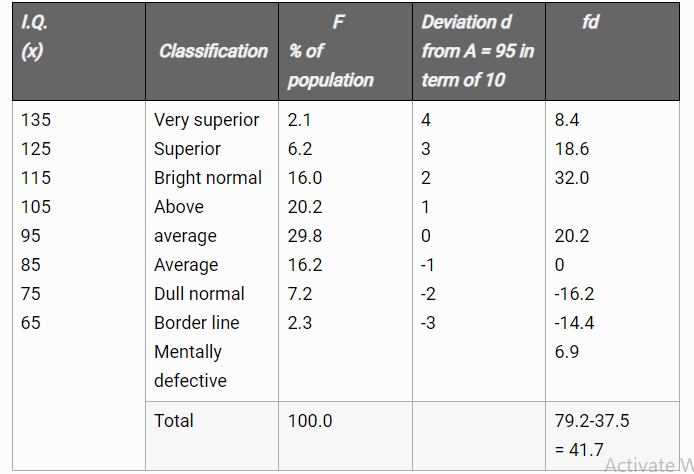
A. 88.4
B. 76.2
C. 80.4
D. None of these
Answer – C. 80.4
29. The average I.Q. of the entire population is nearly
A. 105.3
B. 88.2
C. 99.2
D. None of these
Answer – C. 99.2
30. The ratio of the population classified below ‘Average’ to the total population, is nearly
A. 1/4
B. 1/8
C. 1/3
D. 1/5
Answer – A. 1/4
31. Find total women employees in Dena Bank?
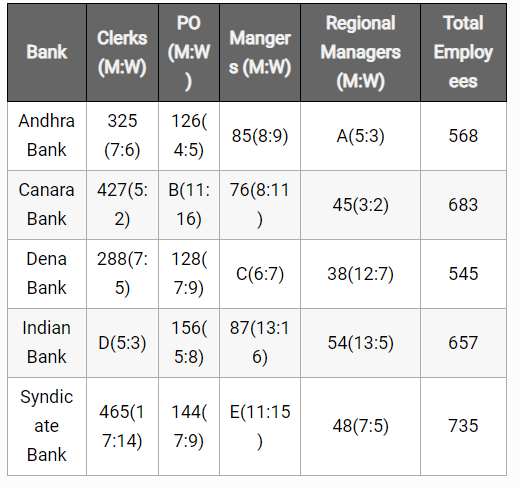
A. 245
B. 247
C. 451
D. 256
Answer – C. 80.4
32. What is the approximate percentage of the Men PO’s in Canara Bank to Total employees in Canara Bank?
A. 9%
B. 8%
C. 7%
D. 6%
Answer – B. 8%
33. Find total Men employees working as Clerks in all banks?
A. 1234
B. 1256
C. 2134
D. 1128
Answer – D.1128
34. Find Sum of E, A, and B?
A. 249
B. 238
C. 223
D. 245
Answer – D. 245
35. What approximate percentage E and C in A, B, and C?
A. 32%
B. 30%
C. 29%
D. 39%
Answer – A. 32%
Explanation:
A = 32
B = 135
C = 91
D = 360
E = 78
C+E = 169
A+B+D =527
Percentage = 169*100/527 = 32.068~=32%
| SBI PO Data Analysis & Interpretation Questions and Answers | |
| To Download SBI PO Data Analysis & Interpretation Questions and Answers PDF (Mains) | Click Here |
Keep in touch with us @ Freshers Now and get more updates on the SBI PO Data Analysis & Interpretation Questions and Answers.



